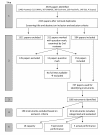Valid and reliable instruments for arm-hand assessment at ICF activity level in persons with hemiplegia: a systematic review
- PMID: 22498041
- PMCID: PMC3352056
- DOI: 10.1186/1471-2377-12-21
Valid and reliable instruments for arm-hand assessment at ICF activity level in persons with hemiplegia: a systematic review
Abstract
Background: Loss of arm-hand performance due to a hemiparesis as a result of stroke or cerebral palsy (CP), leads to large problems in daily life of these patients. Assessment of arm-hand performance is important in both clinical practice and research. To gain more insight in e.g. effectiveness of common therapies for different patient populations with similar clinical characteristics, consensus regarding the choice and use of outcome measures is paramount. To guide this choice, an overview of available instruments is necessary. The aim of this systematic review is to identify, evaluate and categorize instruments, reported to be valid and reliable, assessing arm-hand performance at the ICF activity level in patients with stroke or cerebral palsy.
Methods: A systematic literature search was performed to identify articles containing instruments assessing arm-hand skilled performance in patients with stroke or cerebral palsy. Instruments were identified and divided into the categories capacity, perceived performance and actual performance. A second search was performed to obtain information on their content and psychometrics.
Results: Regarding capacity, perceived performance and actual performance, 18, 9 and 3 instruments were included respectively. Only 3 of all included instruments were used and tested in both patient populations. The content of the instruments differed widely regarding the ICF levels measured, assessment of the amount of use versus the quality of use, the inclusion of unimanual and/or bimanual tasks and the inclusion of basic and/or extended tasks.
Conclusions: Although many instruments assess capacity and perceived performance, a dearth exists of instruments assessing actual performance. In addition, instruments appropriate for more than one patient population are sparse. For actual performance, new instruments have to be developed, with specific focus on the usability in different patient populations and the assessment of quality of use as well as amount of use. Also, consensus about the choice and use of instruments within and across populations is needed.
Figures
References
-
- Wolfe CD. The impact of stroke. Br Med Bull. 2000;56(2):275–286. - PubMed
Publication types
MeSH terms
LinkOut - more resources
Full Text Sources
Miscellaneous



